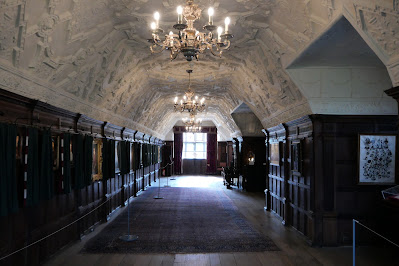Hever Castle began as a country house in the 13th century. From 1462 to 1539, it was the seat of the Boleyn (originally 'Bullen') family. The oldest part of the castle dates to 1270 and consisted of the gatehouse and a walled bailey. The property subsequently passed through various owners, including the Waldegrave family from 1557 to 1715, the Humfreys family to 1749 and the Meade-Waldo family from 1749 to 1903. During this latter period of ownership, the castle fell into a poor state of repair.
Luckily, in 1903, it was acquired and restored by the American millionaire William Waldorf Astor who used it as a family residence. He completed a restoration, added the Tudor village and also added the Italian Garden to display his collection of statuary and ornaments
The Tudor village is a large and quite picturesque collection of buildings. Nowadays you can stay in one of these for Bed & Breakfast.
The Castle is to the right of the Tudor village. Here is the square-on view. It features the oldest working original portcullis in England.
And this is the sideways-on view.
You enter across the bridge and through the massive gatehouse to emerge into a small courtyard which leads to the interior of the castle. The interior is quite opulent with beautiful wood carving everywhere. This dates only from 1903-7. Pevsner describes it as a virtuoso display. The architect was J L Pearson and the carver was W S Frith.
The Inner Hall
The Drawing Room.
The Staircase Gallery was built over the Entrance Hall in c.1506 by Thomas Boleyn to give access between the two wings of the house and his newly built Long Gallery upstairs.
The Long Gallery was constructed in the sixteenth century and extends across the entire width of the Castle. It was used for entertaining guests, taking exercise, and displaying art collections. The panelling dates from the sixteenth century, but the ceiling is an early twentieth-century reconstruction in the Tudor style created by Nathaniel Hitch.
I have focused mainly on the Castle, but there are also extensive grounds, ornamental gardens and a large lake.
And finally, as you enter or leave the Castle you will pass the church of St Peter. It dates from the 12th Century, but was restored in 1894. It contains the tomb of Sir Thomas Bullen, father of Anne Boleyn and grandfather of Queen Elizabeth the First.










No comments:
Post a Comment